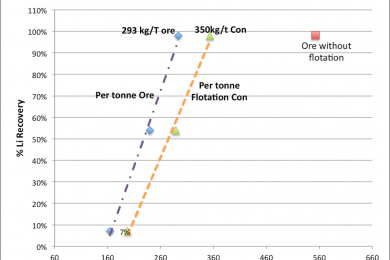Australian-based lithium/boron developer Global Geoscience Ltd (GSC) reports that extensive acid-leach test work at its 100%-owned Rhyolite Ridge lithium-boron project in Nevada, has shown that lithium and boron can be readily extracted by simple heap leach processing with high recoveries.
“This is an exceptional result and a very significant breakthrough as we are not aware of any other lithium deposit where heap leach processing has been successfully demonstrated. Rhyolite Ridge’s unique combination of minerals and low clay content is the key to efficiently recovering lithium and boron via heap leaching,” explained GSC Managing Director Bernard Rowe.
- In an industry first, GSC has successfully demonstrated heap leach processing of Rhyolite Ridge lithium-boron mineralisation by achieving lithium and boron recoveries of 88-92%
- Rapid leach times at ambient temperature with moderate acid consumption rates
- Heap leach processing provides substantially lower operating and capital costs compared to other forms of acid-leach processing as grinding, flotation, filtration and leach tanks are not required
- Global’s Rhyolite Ridge is believed to be the only known lithium deposit in the world that has been demonstrated to be amenable to simple heap leach processing, reinforcing it as a credible alternative to spodumene and brine deposits as a major, low-cost and long-term source of lithium
- Further metallurgy and mining studies are in progress, with engineering studies about to commence. All are part of the company’s Rhyolite Ridge PFS.
The project lies 25 km west of Albermarle’s Silver Peak lithium mine and 340 km from the Tesla Gigafactory near Reno.
Lithium-boron mineralisation is hosted within two sedimentary basins located 4 km apart: South Basin (9 km²) and North Basin (20 km²). The minerals in the host rocks are dominated by the searlesite (boron-bearing), sepiolite (lithium-bearing), K-feldspar, calcite and dolomite.
At South Basin, high-grade lithium-boron mineralisation occurs in 20 to 50 m thick, sub-horizontal sedimentary layers. The upper-most layer is 20 to 30 m thick and outcrops along the western margin of South Basin over a strike length of approximately 3 km.
Drilling at South Basin has defined an Indicated and Inferred Resource of 460 Mt at 0.9% Li2CO3 and 2.6% H3BO3), containing 4.1 Mt of lithium carbonate and 11.9 Mt of boric acid. The Resource is open in most directions and is likely to increase in size with additional drilling.
The Mineral Resource includes a high-grade lithium-boron zone of 137 Mt at 0.9% Li2CO3 and 7.2% H3BO3, with 75% in the Indicated category.










